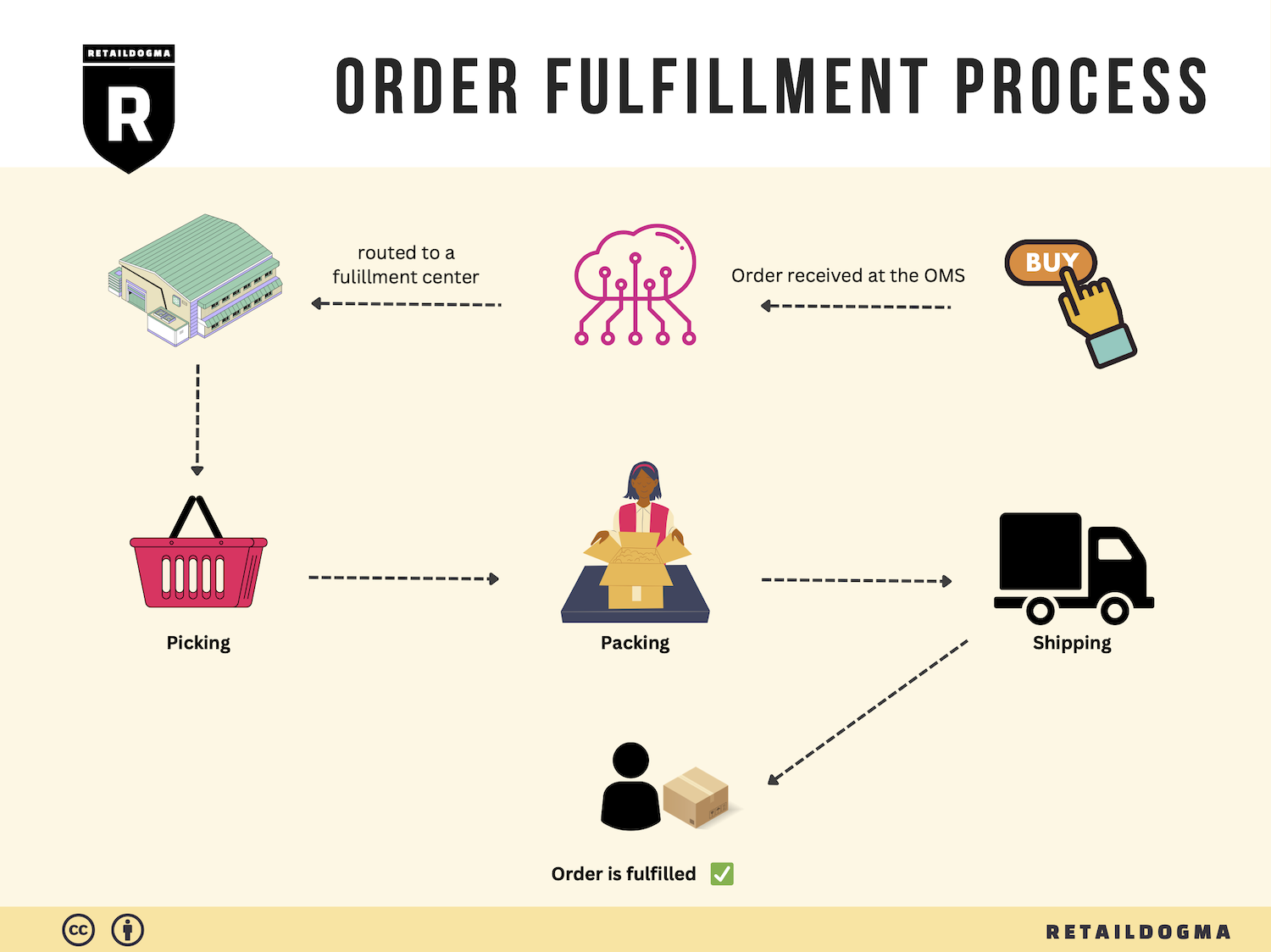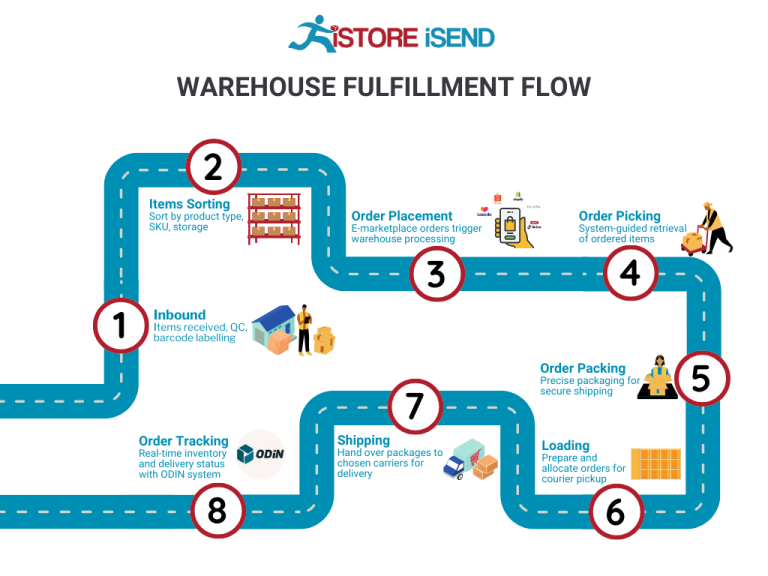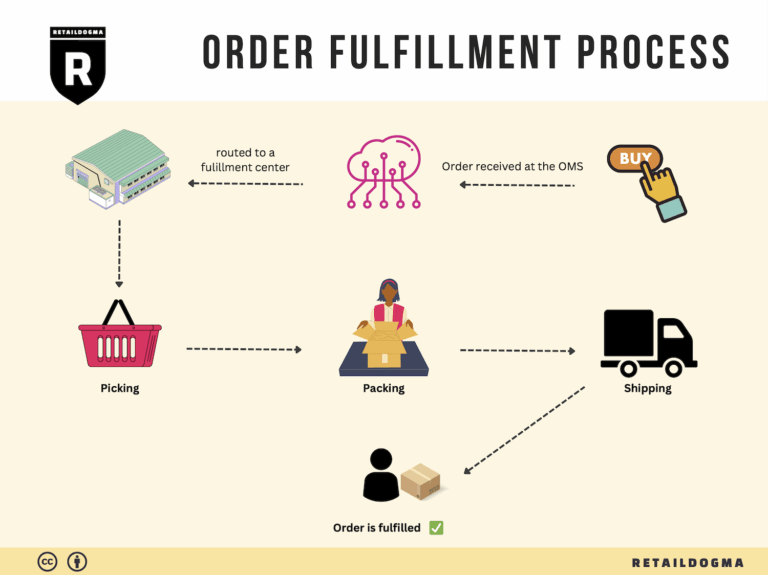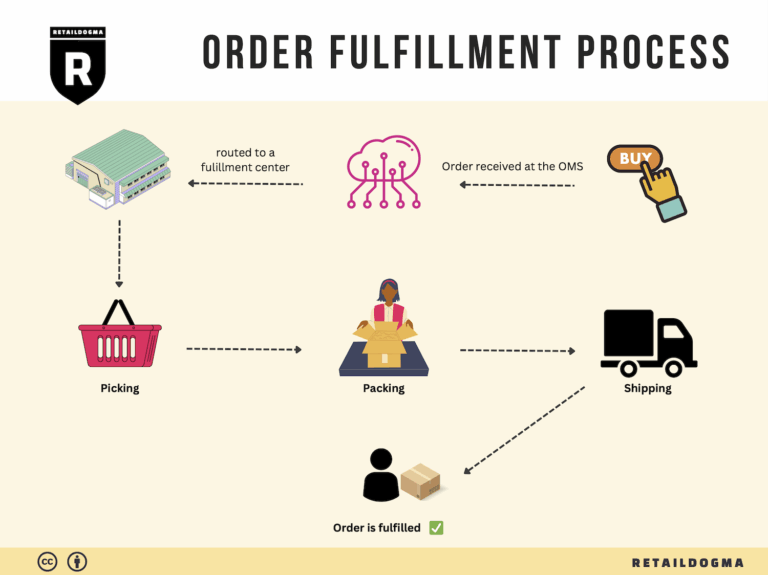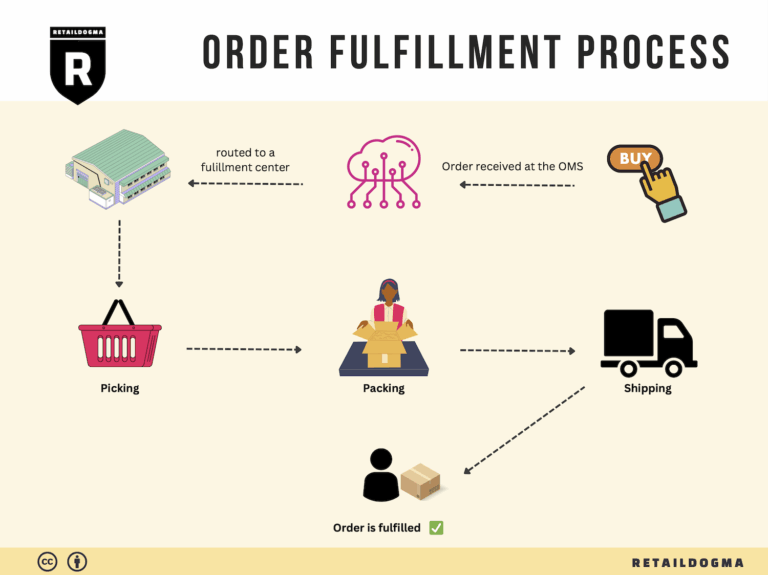What Is A Fulfillment Center? A Complete Guide (2025)
What is E-commerce Fulfillment? An Introduction for Growing Businesses
Understanding E-commerce Fulfillment: A Key to Scaling Your Business
As an e-commerce business owner, the thrill of growing your sales can quickly become overshadowed by the complexities of packing and shipping orders. Managing fulfillment can feel like an overwhelming task, particularly as your customer base expands. Orders pile up, logistics become intricate, and the quality of your service may begin to suffer. This is where understanding e-commerce fulfillment becomes crucial.
In simple terms, fulfillment is the process of getting a product from your warehouse to your customer’s doorstep. It encompasses everything from receiving inventory to storing it, processing orders, packing items, and finally shipping them out. For growing businesses, efficient fulfillment is not just a logistical necessity; it’s a critical component of customer satisfaction and retention.
This guide will delve into the various fulfillment models available to e-commerce businesses, such as Third-Party Logistics (3PL) and Fulfillment by Amazon (FBA). Each model offers unique advantages and challenges, and understanding these can help you make informed decisions that align with your business goals.
We will explore the core services involved in fulfillment, including inventory management, order processing, packaging, and shipping. A clear grasp of these services will enable you to identify what you need from a fulfillment partner to enhance your operational efficiency.
Choosing the right fulfillment partner is another pivotal aspect we will cover. Factors to consider include location, technology capabilities, scalability, and pricing. Your fulfillment partner should not only support your current needs but also be able to grow with you as your business expands.
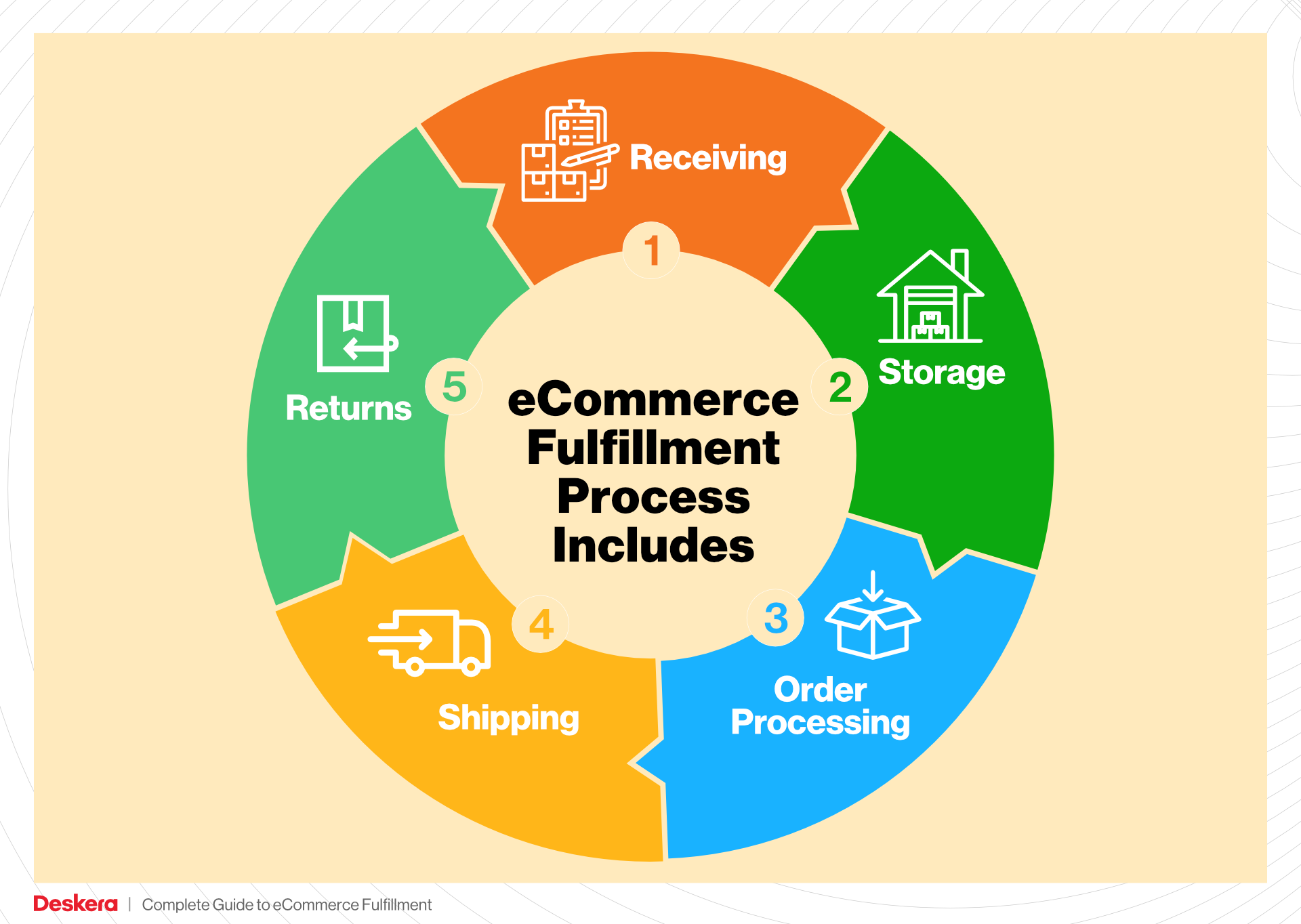
Finally, we’ll discuss pricing structures in the fulfillment landscape. Understanding how pricing works—whether it’s per order, per item, or based on storage space—will help you budget effectively and avoid unexpected costs.
The ultimate goal of this guide is to empower you, the business owner, to make smart, strategic decisions about your logistics. By mastering the fulfillment process, you can enhance your operational efficiency, improve customer satisfaction, and scale your business confidently. Let’s navigate this essential aspect of e-commerce together.
What You’ll Learn In This Guide
- What is E-commerce Fulfillment? An Introduction for Growing Businesses
- The Order Fulfillment Process: From ‘Buy’ Button to Customer’s Door
- Comparing Fulfillment Models: In-House vs. 3PL vs. Dropshipping
- A Deep Dive into Amazon FBA: Pros, Cons, and Who It’s For
- Core Services Offered by Fulfillment Centers
- How to Choose a Fulfillment Partner: A 6-Point Checklist
- Understanding Fulfillment Pricing: A Breakdown of Common Fees
- Frequently Asked Questions (FAQs) about Fulfillment
- Conclusion: Is Outsourcing Fulfillment the Right Move for Your Business?
- Important Disclaimer
The Order Fulfillment Process: From ‘Buy’ Button to Customer’s Door
1. Receiving Inventory
The first step in the order fulfillment process is receiving inventory. This stage involves the acceptance of goods into the fulfillment center, where they are inspected for quality and accuracy against purchase orders. The key term associated with this step is SKU (Stock Keeping Unit), which is a unique identifier for each product.
Receiving inventory is critical because it establishes the foundation for all subsequent operations. Accurate receiving ensures that the inventory counts are correct, which helps prevent stockouts and overstock situations. Any discrepancies identified during this stage can be addressed immediately, thus avoiding issues later in the fulfillment process.
To streamline this process, many businesses utilize advanced scanning technology and warehouse management systems (WMS) that automate the tracking of inventory as it enters the facility. This not only improves accuracy but also enhances efficiency, allowing for faster turnaround times.
2. Warehouse Storage
Once the inventory has been received and verified, it is stored in designated areas within the fulfillment center. The goal of this step is to organize the products in a manner that optimizes space and facilitates easy access. Key terms to consider here are “bin location” and “inventory management system.”
Effective warehouse storage is essential for maximizing operational efficiency. A well-organized storage system enables faster order picking, reduces the time employees spend searching for products, and minimizes the risk of errors. Companies often implement various storage techniques, such as FIFO (First In, First Out) or LIFO (Last In, First Out), depending on the nature of the products being stored.
Moreover, using an inventory management system can provide real-time data on stock levels, helping businesses make informed decisions about restocking and inventory turnover.
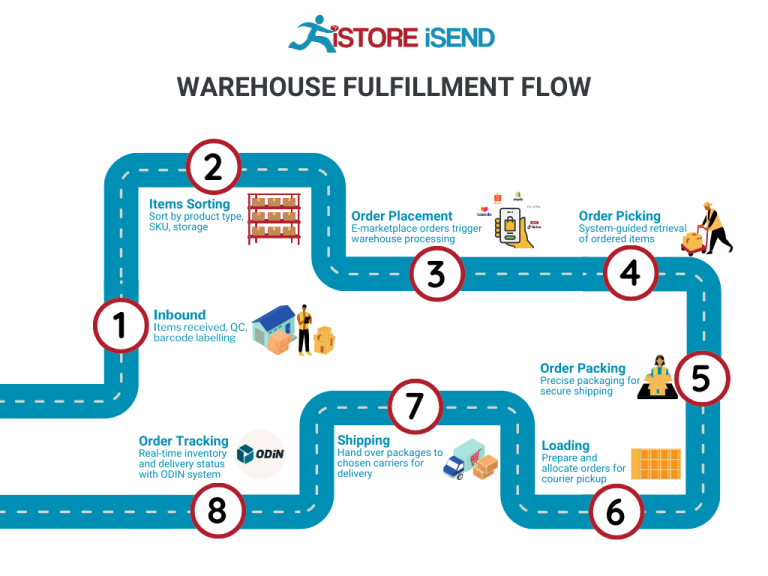
3. Order Picking
Order picking is the process of selecting items from the warehouse to fulfill customer orders. This step is pivotal in the fulfillment process, as it directly impacts order accuracy and customer satisfaction. A key term in this stage is “pick lists,” which are generated documents that detail the items and quantities required for each order.
Efficient order picking is crucial for timely order processing. Different picking methods can be employed, such as single-order picking, batch picking, or zone picking, each suited to different types of operations. Implementing a systematic approach can significantly reduce the time taken to gather products, thereby enhancing overall productivity.
Additionally, employing technology such as handheld scanners or pick-to-light systems can further streamline the picking process, reduce errors, and provide employees with real-time updates on inventory levels.
4. Order Packing
After the items have been picked, they proceed to the packing stage. This involves securely packaging the products for shipment, ensuring they are protected during transit. The key term here is “packing slip,” which includes essential information about the order and is included in the shipment.
Packing is a crucial step that influences the customer experience. Properly packed orders minimize the risk of damage during shipping and improve the likelihood of customer satisfaction upon receipt. Businesses can utilize various packing materials, including bubble wrap, foam peanuts, and custom boxes, to provide adequate protection.
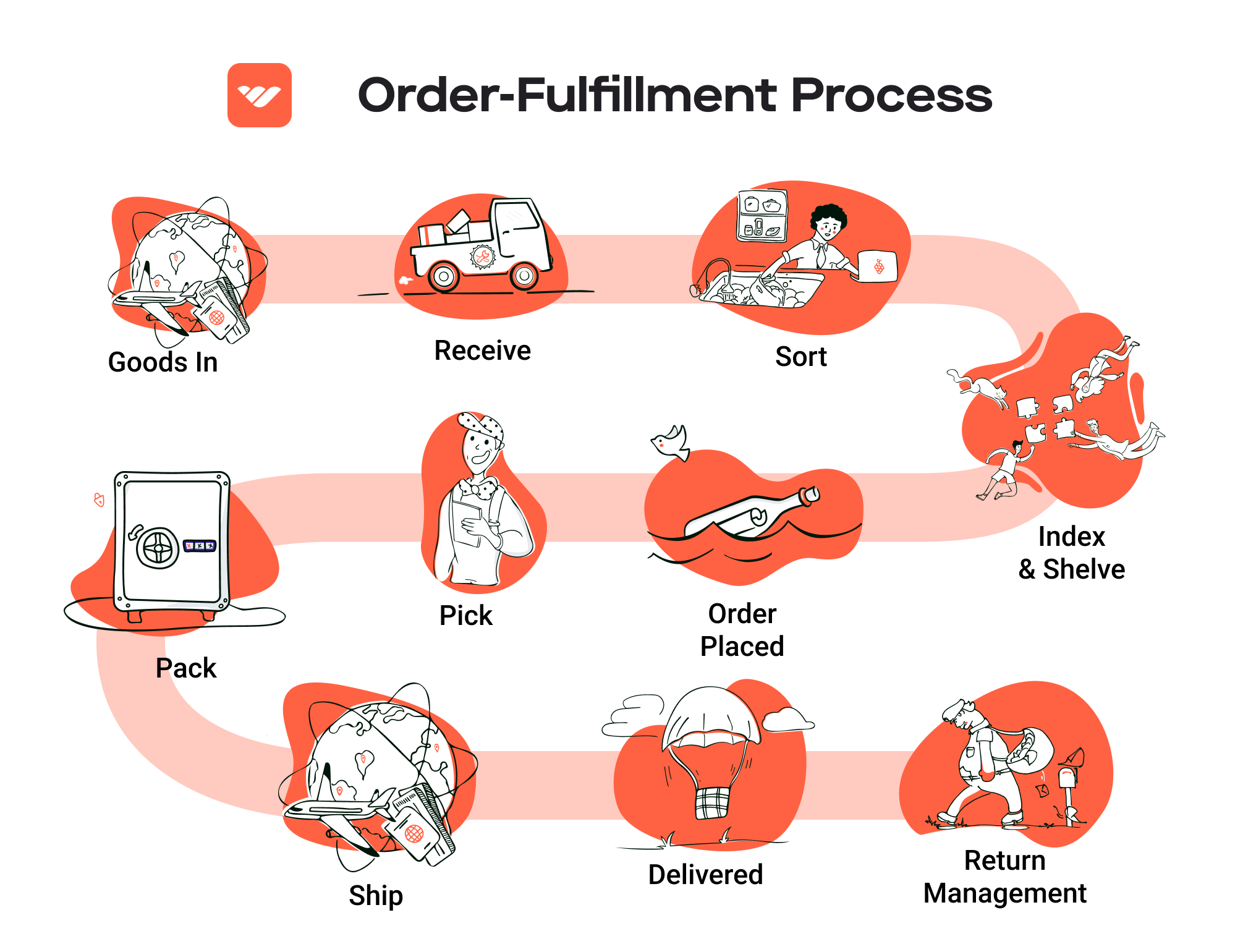
In addition, companies may implement packing stations equipped with scales and label printers to enhance efficiency. This allows for quick weighing and labeling of packages, ensuring that they are ready for shipment without unnecessary delays.
5. Shipping & Delivery
The final step in the order fulfillment process is shipping and delivery. Once orders are packed, they are dispatched to shipping carriers for delivery to customers. Key terms relevant to this stage include “last-mile delivery” and “shipping methods.”
Shipping and delivery are critical components of the customer experience. The speed and reliability of delivery can significantly impact customer satisfaction and brand loyalty. Businesses must choose the right shipping methods based on factors such as cost, delivery speed, and geographic reach.
Moreover, leveraging technology, such as tracking systems and logistics software, can provide customers with real-time updates on their orders, further enhancing their experience. Efficient last-mile delivery strategies, including partnerships with local couriers or using fulfillment centers closer to customer locations, can also help reduce delivery times.
By understanding and optimizing each step of the order fulfillment process, e-commerce businesses can enhance their operational efficiency, reduce costs, and ultimately improve customer satisfaction.
Comparing Fulfillment Models: In-House vs. 3PL vs. Dropshipping
Comparison of Fulfillment Models
| Model | Who Handles Inventory | Best For (Business Stage) | Key Advantage | Key Disadvantage |
|---|---|---|---|---|
| In-House Fulfillment | Business owns and manages inventory | Established businesses with sufficient capital | Complete control over inventory and processes | High upfront costs and operational complexity |
| Third-Party Logistics (3PL) | 3PL provider manages inventory | Growing businesses looking to scale | Access to expertise and scalable solutions | Less control over operations and potential communication issues |
| Dropshipping | Supplier/manufacturer manages inventory | Startups and low-capital businesses | Minimal upfront investment and risk | Lower profit margins and dependency on suppliers |
In-House Fulfillment
In-house fulfillment is a model where the e-commerce business itself manages all aspects of inventory handling, including storage, packing, and shipping. This approach is ideal for established businesses that have the capital and resources to invest in warehousing and logistics operations. One of the primary advantages of in-house fulfillment is the complete control it provides over inventory management, order processing, and shipping timelines. Businesses can implement their own quality control measures and customize packaging to enhance the customer experience. However, this model also comes with significant drawbacks, including high upfront costs for warehousing and equipment, as well as the ongoing operational complexity of managing logistics. As businesses scale, they may find it increasingly challenging to maintain efficiency and meet growing demand without substantial investment in infrastructure and personnel.
Third-Party Logistics (3PL)
Third-party logistics (3PL) providers specialize in managing logistics operations for businesses. They handle various functions, including warehousing, inventory management, order fulfillment, and shipping. This model is particularly beneficial for growing businesses that want to scale their operations without the heavy burden of managing logistics themselves. By leveraging a 3PL, businesses gain access to the provider’s expertise and established infrastructure, which can lead to improved efficiency and cost savings. Additionally, 3PLs often offer flexible solutions that can adapt to fluctuating order volumes, making them ideal for businesses experiencing seasonal spikes in demand. However, one of the key disadvantages of using a 3PL is the reduced control over the fulfillment process. Businesses may encounter communication challenges and inconsistencies in service quality, which can impact customer satisfaction. Furthermore, reliance on a third party for logistics can lead to complications if the provider faces operational issues.
Dropshipping
Dropshipping is a fulfillment model where the retailer does not hold inventory but instead transfers customer orders directly to a supplier or manufacturer, who then ships the products to the customer. This model is particularly attractive for startups and businesses with limited capital, as it requires minimal upfront investment. With dropshipping, businesses can offer a wide range of products without the risk of unsold inventory, allowing them to test new items quickly and pivot their offerings based on market demand. Additionally, the reduced operational burden allows entrepreneurs to focus on marketing and sales rather than logistics. However, dropshipping comes with its own set of challenges. The profit margins are typically lower than in other fulfillment models due to the reliance on suppliers, and businesses can face issues with stock availability and shipping times, which can lead to customer dissatisfaction. Furthermore, the lack of control over product quality and fulfillment processes can lead to brand reputation risks if suppliers do not meet expectations.
In summary, each fulfillment model has its unique benefits and challenges, making it essential for e-commerce business owners and operations managers to carefully consider their specific needs, resources, and growth strategies when selecting a fulfillment approach.
A Deep Dive into Amazon FBA: Pros, Cons, and Who It’s For
Understanding Fulfillment by Amazon (FBA)
Fulfillment by Amazon (FBA) is a service provided by Amazon that allows sellers to store their products in Amazon’s fulfillment centers. Amazon takes care of storage, packaging, shipping, and customer service for these products. This means that when a customer orders a product, Amazon handles the entire process from order receipt to delivery, allowing sellers to focus on other aspects of their business.
How FBA Works
-
Setting Up: Sellers need to create an Amazon Seller account and choose the FBA option. They can then prepare their products for shipment to Amazon’s fulfillment centers.
-
Shipping Products: Sellers send their products to Amazon. They can either ship them in bulk to a single fulfillment center or have Amazon direct them to multiple centers based on demand.
-
Storage: Once the products arrive at the fulfillment center, they are stored until sold. Amazon provides real-time inventory tracking, allowing sellers to monitor stock levels.
-
Order Fulfillment: When a customer places an order, Amazon picks, packs, and ships the product on behalf of the seller. They also handle customer service and returns.
-
Payment: After the product is sold, Amazon deducts its fees and transfers the remaining amount to the seller’s bank account.
Pros of Using FBA
-
Prime Eligibility: Products fulfilled by Amazon are eligible for Amazon Prime, which can significantly boost sales. Prime members often prefer Prime-eligible products due to faster shipping and convenience.
-
Customer Trust: Amazon has built a reputation for reliability and customer service. By using FBA, sellers can leverage this trust, as customers are often more likely to purchase products that are fulfilled by Amazon.
-
Multi-Channel Fulfillment: FBA allows sellers to fulfill orders not only from Amazon but also from their own websites or other sales channels. This means that sellers can centralize their inventory and logistics through Amazon, streamlining their operations.
-
Scalability: As businesses grow, FBA can help scale operations without the need for additional investment in warehousing and logistics. Amazon’s infrastructure allows sellers to reach a larger audience without the complexities of managing fulfillment.
-
Time Savings: By outsourcing fulfillment to Amazon, sellers can save time on logistics, allowing them to focus on marketing, product development, and other critical business activities.
Cons of Using FBA
-
High Fees: FBA fees can accumulate quickly, with costs for storage, fulfillment, and other services. Sellers must carefully consider these fees when pricing their products to ensure profitability.
-
Strict Inventory Rules: Amazon has specific guidelines regarding inventory management, including storage limits and performance metrics. Sellers must adhere to these rules or risk penalties, including increased fees or account suspension.
-
Commingling Risks: FBA allows for commingling of inventory, meaning that products from different sellers can be stored together. This can lead to issues with counterfeit products or items being mixed up, potentially damaging a seller’s reputation.
-
Loss of Control: By using FBA, sellers relinquish some control over the fulfillment process. They rely on Amazon’s systems, which can sometimes lead to issues such as delays or mismanagement of stock.
-
Returns Management: While Amazon handles customer service, the returns process can be complicated for sellers. Returned products may not always be in sellable condition, which can lead to losses.
Who is FBA Best For?
Fulfillment by Amazon is particularly beneficial for small to medium-sized e-commerce businesses looking to scale quickly without the complexities of managing logistics. Here are some specific scenarios where FBA may be the best fit:
-
New Sellers: Entrepreneurs just starting out can benefit from Amazon’s established infrastructure and customer base, allowing them to enter the market with less risk.
-
Product Categories with High Demand: Sellers of fast-moving consumer goods or seasonal products can take advantage of Amazon’s logistics to meet demand efficiently.
-
Brands with Limited Resources: Businesses that lack the resources or expertise to handle fulfillment can leverage FBA to ensure their products are delivered quickly and reliably.
-
Multi-Channel Retailers: Companies that sell across various platforms (e.g., their own website, eBay, etc.) can streamline their operations by using FBA for all orders, simplifying inventory management.
-
Sellers Seeking Growth: Businesses looking to expand their reach and grow their sales can utilize FBA to access Amazon’s vast customer base while minimizing the burden of logistics.
In conclusion, while Fulfillment by Amazon offers numerous advantages that can help scale a business, it’s essential for sellers to weigh these benefits against the potential drawbacks. By understanding how FBA works and assessing their own business needs, sellers can make informed decisions about whether this service aligns with their growth strategy.
Core Services Offered by Fulfillment Centers
Inventory Management & Warehousing
Inventory management and warehousing are foundational services provided by fulfillment centers, ensuring that e-commerce businesses can efficiently store and manage their stock. Fulfillment centers utilize advanced inventory tracking systems that integrate with e-commerce platforms, allowing businesses to monitor stock levels in real-time. This service includes receiving shipments, organizing products within the warehouse, and maintaining optimal stock levels to prevent overstocking or stockouts.
The benefits of effective inventory management are multifaceted. First, it enhances operational efficiency by streamlining the storage process and reducing time spent searching for products. Additionally, accurate inventory tracking minimizes the risk of human error, ensuring that orders are fulfilled correctly and promptly. By leveraging these services, e-commerce businesses can maintain better control over their inventory, ultimately leading to improved customer satisfaction through timely deliveries and accurate order fulfillment.
Pick and Pack Services
Pick and pack services are crucial for e-commerce businesses as they transform bulk inventory into individual orders ready for shipment. This process involves selecting the correct items from the warehouse (picking) and then packaging them for delivery (packing). Fulfillment centers employ skilled staff and sophisticated technology to ensure that this process is executed efficiently and accurately.
The primary advantage of pick and pack services lies in their ability to scale with an e-commerce business. As sales volumes fluctuate, fulfillment centers can adjust their operations to handle increased or decreased order quantities without the need for businesses to invest in additional staffing or infrastructure. This flexibility is particularly beneficial during peak shopping seasons, such as holidays or promotional events, where demand can surge unexpectedly. Furthermore, well-executed pick and pack operations enhance customer experience by ensuring that orders are fulfilled accurately and shipped quickly, reducing the likelihood of returns and increasing customer loyalty.
Kitting and Assembly
Kitting and assembly services offered by fulfillment centers involve combining multiple products into a single package or assembling products before shipping them to customers. This service is particularly valuable for businesses that sell bundled products or require items to be assembled before reaching the consumer. For instance, a company selling a DIY furniture kit would benefit from having the components pre-assembled and packaged together.
The key benefit of kitting and assembly is the ability to streamline the customer experience. By providing customers with a ready-to-use product, businesses can enhance satisfaction and reduce the complexity of their offerings. Moreover, this service can lead to increased sales, as customers are often more inclined to purchase bundled products that offer convenience. Additionally, fulfillment centers can manage inventory more effectively by consolidating items into kits, which can simplify stock management and reduce the risk of surplus inventory.
Returns Management (Reverse Logistics)
Returns management, also known as reverse logistics, is a critical service provided by fulfillment centers that deals with the processing of returned products. This includes receiving returned items, inspecting them for quality, restocking sellable items, and managing the disposal or recycling of damaged goods. Efficient returns management is essential for e-commerce businesses, as it directly impacts customer satisfaction and retention.
The benefits of an effective returns management system are significant. First, it provides customers with a seamless return experience, which is crucial in today’s e-commerce landscape where consumers expect hassle-free returns. By managing returns efficiently, businesses can enhance their reputation and build customer loyalty. Furthermore, a well-organized returns process allows businesses to analyze return data, identifying patterns that can inform product development and inventory decisions. This insight can lead to improved product quality and reduced return rates, ultimately driving profitability.
In conclusion, the core services offered by fulfillment centers—inventory management and warehousing, pick and pack services, kitting and assembly, and returns management—are integral to the success of e-commerce businesses. By leveraging these services, companies can streamline their operations, enhance customer satisfaction, and position themselves for scalable growth in a competitive marketplace.
How to Choose a Fulfillment Partner: A 6-Point Checklist
Location & Warehouse Network
When selecting a fulfillment partner, the location of their warehouses is a critical factor. The proximity of their facilities to your target market can significantly impact shipping times and costs.
Why It’s Important:
– Shorter shipping distances lead to faster delivery times, which can enhance customer satisfaction.
– Reduced shipping costs can improve your profit margins.
Questions to Ask:
– Where are your warehouses located, and how do they align with my customer base?
– Can you provide insights into your delivery times to my primary markets?
– Do you have multiple locations to support regional distribution?
Technology & Integrations
A fulfillment partner’s technology stack is essential for seamless operations. Their systems should integrate easily with your e-commerce platforms, inventory management tools, and customer relationship management (CRM) systems.
Why It’s Important:
– Efficient technology can automate order processing, reduce errors, and provide real-time tracking.
– Integration capabilities ensure that your operations remain streamlined and connected.
Questions to Ask:
– What order management systems do you use, and how do they integrate with major e-commerce platforms?
– Can you provide real-time inventory updates?
– What technology do you use to handle returns and exchanges?
Specializations (e.g., Cold Storage, Oversized Items)
Depending on your product range, you may require specific capabilities from your fulfillment partner. This could include cold storage for perishable goods or handling oversized items.
Why It’s Important:
– Specialized services ensure that your products are stored and shipped correctly, maintaining their quality.
– It can also help you reach niche markets that require specific handling.
Questions to Ask:
– What types of products do you specialize in handling?
– Do you have the necessary facilities (e.g., climate-controlled environments) for my products?
– How do you ensure compliance with regulations related to specialized storage?
Scalability & Capacity
Your fulfillment partner should be able to scale operations in line with your business growth. Assess their capacity to handle increased order volumes, especially during peak seasons.
Why It’s Important:
– A partner that can scale with you can support your growth without service interruptions.
– Adequate capacity ensures that you can meet customer demand at all times.
Questions to Ask:
– How do you manage seasonal fluctuations in order volume?
– Can you provide examples of how you have scaled your operations for other clients?
– What is your maximum capacity, and how quickly can you adapt to increased demand?
Pricing and Contracts
Understanding the pricing structure and contract terms is crucial to avoid unexpected costs. A transparent pricing model can help you budget effectively.
Why It’s Important:
– Clear pricing helps you understand the cost of services and allows for better financial planning.
– Flexible contract terms can provide peace of mind and adaptability.
Questions to Ask:
– Can you provide a detailed breakdown of your pricing structure?
– Are there any additional fees I should be aware of (e.g., storage, handling, shipping)?
– What are the terms of the contract, and how easy is it to make adjustments if needed?
Customer Support & Reviews
Exceptional customer support is essential for resolving issues quickly and maintaining a positive relationship. Additionally, researching reviews and testimonials from other clients can provide insight into their reliability and service quality.
Why It’s Important:
– Responsive customer support can mitigate disruptions in your supply chain.
– Positive reviews indicate a track record of reliability and customer satisfaction.
Questions to Ask:
– What customer support channels do you offer (e.g., phone, email, chat)?
– How quickly can I expect a response to inquiries or issues?
– Can you share references or case studies from clients with similar needs?
Conclusion
Choosing the right fulfillment partner is a pivotal decision that can impact your business’s efficiency, customer satisfaction, and ultimately, your bottom line. By thoroughly evaluating potential partners using this checklist, you can make a more informed decision that aligns with your operational goals and customer expectations. Always remember to conduct thorough due diligence and trust your instincts when selecting a partner that fits your specific needs.
Understanding Fulfillment Pricing: A Breakdown of Common Fees
Initial Setup Fees
When beginning your relationship with a fulfillment center, such as those operated by Amazon in San Antonio, you may encounter initial setup fees. These fees cover the costs associated with onboarding your business into the fulfillment system. Typically, this includes setting up your account, integrating your e-commerce platform with the fulfillment software, and configuring any specific requirements for your inventory management.
Initial setup fees can vary widely based on the complexity of your operations and the services you require. Some fulfillment centers may waive these fees as part of promotional offers or when you commit to a longer-term contract. It’s essential to clarify what is included in these fees and if there are any ongoing maintenance costs associated with your account.
Receiving Fees
Receiving fees are charged when the fulfillment center accepts and processes your inventory. This fee typically covers the costs of unloading, inspecting, and entering the goods into the warehouse management system. The calculation of receiving fees can depend on several factors, including the volume of items received, the time it takes to process them, and whether the goods require special handling.
Fulfillment centers may have tiered pricing for receiving fees based on the number of pallets or boxes you send. For instance, a facility might charge a lower rate per pallet if you send a larger shipment. Understanding these fees upfront can help you manage your inventory more efficiently and minimize costs.
Storage Fees (per pallet/bin)
Storage fees are incurred for the space your products occupy within the fulfillment center. These fees are typically calculated on a per-pallet or per-bin basis and are charged monthly. The cost can vary depending on the size of your inventory and the duration it remains in storage.
Many fulfillment centers have specific guidelines regarding the maximum allowable time for items to be stored. For example, if products remain in storage longer than a specified period, additional long-term storage fees may apply. To optimize storage costs, consider implementing effective inventory management practices that reduce excess stock and turnover times.
Pick & Pack Fees (per item/order)
Pick and pack fees are charged for the labor involved in retrieving items from storage and preparing them for shipment. This fee is usually calculated on a per-item or per-order basis. For example, a fulfillment center may charge a flat rate for each order processed, plus an additional fee for each item picked from the shelf.
Understanding how pick and pack fees are structured is crucial for budgeting, especially if your business experiences fluctuations in order volume. Some fulfillment centers offer discounts for high-volume orders, so it’s beneficial to discuss your expected order quantities with your provider to negotiate better rates.
Shipping Fees
Shipping fees encompass the costs associated with transporting orders from the fulfillment center to your customers. These fees can vary based on several factors, including the shipping method selected (e.g., standard, expedited), the destination, and the weight and dimensions of the package.
Fulfillment centers often partner with multiple shipping carriers, allowing businesses to choose the most cost-effective shipping solutions. Some centers may offer discounted shipping rates based on volume, which can significantly reduce overall fulfillment costs. It’s essential to assess your shipping needs and discuss available options with your fulfillment partner to ensure you’re optimizing your logistics strategy.
Tips for Getting an Accurate Quote
To receive an accurate fulfillment pricing quote, consider the following tips:
-
Be Transparent: Provide detailed information about your inventory, order volume, and any specific requirements. The more information you share, the better the fulfillment center can tailor their quote to your needs.
-
Request a Breakdown: Ask for a detailed breakdown of all potential fees, including any additional or hidden costs that may arise. This will help you avoid surprises down the line.
-
Compare Multiple Providers: Don’t settle for the first quote you receive. Compare pricing structures and services offered by several fulfillment centers to ensure you’re getting the best deal.
-
Negotiate: Many fulfillment centers are open to negotiation, especially if you can commit to higher volumes or longer contracts. Leverage your business needs to secure better pricing.
-
Factor in Scalability: As your business grows, your fulfillment needs will evolve. Ensure the provider you choose can accommodate your future growth without drastically increasing costs.
By understanding these common fulfillment pricing models and following these tips, you can make informed decisions that support your e-commerce business’s growth and profitability.
Frequently Asked Questions (FAQs) about Fulfillment
1. What is the Amazon Fulfillment Center in San Antonio?
The Amazon Fulfillment Center in San Antonio, including facilities like DSX1 and DSX3, is a large-scale distribution hub designed for storing, packing, and shipping a variety of products. These centers are pivotal in Amazon’s logistics network, ensuring timely delivery to customers in the region and contributing to the overall efficiency of e-commerce operations.
2. How does the Amazon Fulfillment Center operate?
Amazon Fulfillment Centers utilize advanced technology and logistics systems to streamline the fulfillment process. Products are received, stored, picked, packed, and shipped from these facilities. Automated systems help optimize inventory management, ensuring that orders are processed quickly and accurately.
3. What are the benefits of using Amazon Fulfillment Centers for my e-commerce business?
Using Amazon Fulfillment Centers can significantly enhance your business’s logistics efficiency. Benefits include:
– Fast Shipping: Access to Amazon’s logistics network ensures quicker delivery times.
– Scalability: Easily scale your operations as your sales grow without needing to manage a warehouse.
– Reduced Overhead: Save on warehousing costs, labor, and inventory management.
– Customer Trust: Leverage Amazon’s reputation for reliability, which can enhance your brand’s credibility.
4. What is the difference between a warehouse and a fulfillment center?
A warehouse primarily focuses on storing goods, while a fulfillment center specializes in processing and shipping orders. Fulfillment centers are equipped with technology and systems that enable them to pick, pack, and ship products directly to customers, whereas warehouses might not have the same level of operational efficiency or shipping capabilities.
5. What is a 3PL (Third-Party Logistics) provider?
A 3PL provider is a company that offers outsourced logistics services, including warehousing, fulfillment, and transportation. Businesses often partner with 3PLs to manage their supply chain operations more efficiently, allowing them to focus on core activities like marketing and sales. Amazon itself acts as a 3PL for many sellers using its fulfillment services.
6. How much do fulfillment services cost?
Fulfillment service costs can vary widely based on factors such as order volume, storage requirements, and specific service levels. Generally, costs may include:
– Storage Fees: Charged based on the amount of space your products occupy in the fulfillment center.
– Fulfillment Fees: Charged per unit for picking, packing, and shipping orders.
– Additional Fees: These may include charges for returns, special packaging, or inventory management services.
7. What types of products can be stored at Amazon Fulfillment Centers?
Amazon Fulfillment Centers can store a wide range of products, from consumer goods and electronics to clothing and household items. However, certain restrictions apply, especially for hazardous materials, perishables, and items requiring special handling.
8. How do I send my products to an Amazon Fulfillment Center?
To send your products to an Amazon Fulfillment Center, you need to create a shipment plan through your Amazon Seller Central account. This process involves selecting the products you want to ship, determining quantities, and labeling your packages according to Amazon’s requirements. Once your shipment is prepared, you can schedule a delivery to the designated fulfillment center.
9. Can I use Amazon Fulfillment Centers for international shipping?
Yes, Amazon Fulfillment Centers can facilitate international shipping for products listed on Amazon. By enrolling in the Fulfillment by Amazon (FBA) program, sellers can reach customers in various countries, benefiting from Amazon’s global logistics network. However, sellers must comply with international shipping regulations and customs requirements.
10. How can I track my inventory in an Amazon Fulfillment Center?
Amazon provides real-time inventory tracking through the Seller Central dashboard. Sellers can monitor stock levels, sales trends, and receive notifications when inventory is low. This feature helps businesses manage their inventory efficiently and avoid stockouts, ensuring they can meet customer demand without delays.
Conclusion: Is Outsourcing Fulfillment the Right Move for Your Business?
Evaluating the Benefits of Outsourcing Fulfillment
Outsourcing fulfillment can be a transformative decision for e-commerce businesses looking to scale efficiently. The primary benefits include significant time savings, enhanced scalability, and access to specialized expertise that can streamline operations. By leveraging a fulfillment service, businesses can offload the complexities of inventory management, packing, and shipping—allowing them to focus on core activities such as product development and marketing. This shift can lead to improved operational efficiency, enabling quicker response times to market demands and customer needs.
Moreover, partnering with an experienced fulfillment provider offers the scalability necessary for growth. As your business expands, a robust fulfillment partner can handle increased order volumes without the need for substantial investments in warehousing or staffing. This flexibility is crucial in today’s fast-paced e-commerce landscape, where consumer expectations for speedy delivery continue to rise.
However, choosing the right fulfillment partner is paramount. It’s essential to consider factors such as location, technology integration, service quality, and the provider’s track record in the industry. A strategic partnership can not only enhance your logistics capabilities but also contribute to a superior customer experience, fostering loyalty and repeat business.
Call to Action: Audit Your Current Shipping Process
As you contemplate whether outsourcing fulfillment is the right move for your business, consider conducting an audit of your current shipping process. Evaluate your operational bottlenecks, shipping costs, and customer satisfaction levels. This analysis will help you determine if a fulfillment partner can provide the efficiencies and advantages needed to drive your business forward. Take the first step toward growth by exploring fulfillment options that align with your business objectives and customer expectations.
Important Disclaimer
⚠️ Important Disclaimer
The information in this guide is for educational purposes. Fulfillment services, pricing, and platform features change frequently. Always conduct your own due diligence and consult with providers directly before making business decisions.
